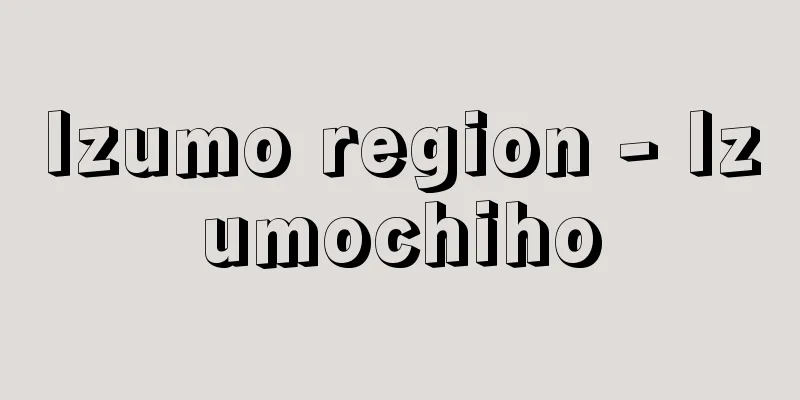Cotton Fabric - Menorimono

|
A fabric made from cotton thread. It was already woven in India in ancient times, and is said to have been introduced to Egypt around 500 B.C., but wool and linen were the mainstream fabrics in Western Europe for a long time, and cotton fabrics only became popular after the Industrial Revolution in the 18th century. In Japan, there was cotton (yu) from long ago, which was a fabric made from plant fibers such as linen, paper mulberry, and wisteria, as opposed to silk. There is a record of cotton being brought to Japan in 799, but it seems to have disappeared soon after, and cotton cultivation is said to have begun at the end of the Muromachi period. In the Edo period, cotton fabrics began to be produced in various places, and Mikawa cotton, Kawachi cotton, and Moka cotton were well known for white cotton, and Kurume kasuri, Iyo kasuri, and Banshu kasuri were well known for cotton kasuri. Cotton fabrics are generally warm, durable, highly absorbent, and heat resistant. They are somewhat weak to acids but resistant to alkalis, and can be made shiny and smooth by mercerization. It also has a high dye absorption rate and does not generate static electricity. It is prone to shrinkage and wrinkling, but recently it has been processed to be wrinkle-resistant and shrink-proof. It is inexpensive, so it has a wide range of uses, including practical clothing, interior decoration, and parts for machines and equipment. Plain weaves include gauze, kanakin, tenjiku cotton, and calico, twill weaves include unsai weave and denim, satin weaves include cotton satin, and wool-blend weaves include towels and corduroy. → Textiles/Cotton → Related topics Textile industry | Cotton industry | Cotton Source : Heibonsha Encyclopedia About MyPedia Information |
|
綿糸を用いた織物。すでにインドでは古代から織られ,前500年ごろにはエジプトに伝えられたというが,西欧では長く毛と麻が織物の主流であり,綿織物が本格的になったのは18世紀の産業革命以後である。日本では古く木綿(ゆう)があったが,これは絹に対して麻やコウゾ,フジなどの植物繊維でつくる布のことであった。799年にワタがもたらされた記録があるがまもなく絶滅したらしく,ワタ栽培が始められたのは室町末期からとされる。江戸時代になって各地で綿織物が生産されるようになり,白木綿(もめん)では三河木綿,河内木綿,真岡(もおか)木綿などが知られ,綿絣(がすり)では久留米絣,伊予絣,播州絣などが知られていた。綿織物は一般に保温力,耐久力があり,吸水性に富み熱にも強い。酸には幾分弱いがアルカリには強く,マーセリゼーションにより光沢を出し平滑にすることができる。また,染料の吸着度が高く,静電気が起きにくい。縮みやすく皺(しわ)になりやすいが,最近は防皺(ぼうしゅう)加工,防縮加工が行われている。安価なので実用的な衣料や室内装飾品,機械や器具の部品布などとして用途が広い。平織にはガーゼ,金巾(かなきん),天竺(てんじく)木綿,キャラコなど,綾織には雲斎織,デニムなど,繻子(しゅす)織には綿サテンなど,添毛織にはタオル,コール天などがある。→織物/綿花 →関連項目織物工業|綿業|木綿 出典 株式会社平凡社百科事典マイペディアについて 情報 |
>>: Immunotherapy - Men'ekiryoho (English spelling) Immune therapy/Immunotherapy
Recommend
Right to explanation - Shakumeiken
It refers to the power of the court to ask questi...
Vagina - Chitsu
It is a part of the female internal genitalia, a ...
Jacob van Artevelde
Around 1290 - 1345 Flemish politician. Also read a...
Elaeagnus multiflora (English spelling) Elaeagnus multiflora
… [Okamoto Motoji]. … *Some of the terminology th...
Educational Play - Lehrstück (English: Lehrstück) [Germany]
This is the name given to a series of plays that B...
Tai-yi-jiao (English spelling)
A Taoist sect founded by the Taoist priest Xiao Ba...
Kanegafuchi Spinning Shinmachi Factory
...During the Edo period, it was a post town on t...
Iwai Prefecture
...Furthermore, Kurihara Prefecture was partly in...
Jingasauni - Jingasauni
This sea urchin is a marine animal that belongs t...
White-spotted tussock moth (Euproctis similis)
An insect of the Lepidoptera family, Lymantriidae ...
Matter book - Matter
〘noun〙① In a document, the act of writing items su...
Kerle, J.de (English spelling) KerleJde
...The strong expressive power of the music, whic...
Kiriani's reaction - Kiriani's reaction
…(3) Epoxides are reacted with hydrogen cyanide. ...
Robertson, OH (English spelling) RobertsonOH
…This treatment prevents the development of jaund...
Gazette des Beaux-Arts
Founded in Paris in 1859, it is the oldest monthly...









